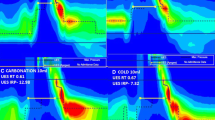Abstract
The acoustic technique has been used forpharyngeal exploration but to date no such technique hasbeen devised to assess esophageal motility. The aim ofthis study was to demonstrate that displacement through the esophagus can be quantified using thismethod in healthy subjects and in patients withgastroesophageal reflux. Concurrent manometric andacoustic recordings were also performed in the patients.Fifteen controls (38.5 ± 13 years old) and 10patients (34.9 ± 6 years old) were included. Allwere recorded during wet and dry swallow sequences withmicrophones placed below the cricoid cartilage and onthe xiphoid appendix. Standard manometry wasperformed for lower esophageal sphincter (LES)exploration. For the acoustic technique, the frequencyof xiphoid signals (FX), esophageal transit time (ETT),duration of xiphoid sound (SD), and for the manometricstudy, the duration of LES relaxation (RD) were recordedand mean values were calculated (FXm), (ETTm), (SDm),(RDm). FXm for wet (94 vs 81.6%) and dry swallows (86 vs 66.6%) decreased in patients. ETTm wassignificantly higher (P < 0.01) for wet than for dryswallows (5.6 ± 0.9 vs 5.2 ± 1.2 sec) forcontrols but not for patients. ETTm was significantly higher for patients for wet (7.2 ± 2.1sec) and for dry swallows (6.5 ± 2.3 sec) thanfor controls and SDm was lower. Xiphoid sound appearedin the second half of LES relaxation. Our noninvasiveacoustic technique is simple and reproducible. It iswell correlated with manometry, and it allowscharacterization of the displacement of the bolusthrough the esophagus and the LES. The technique couldbe used alone to determine appropriate pharmacologicaland surgical treatments for esophageal motilitydisorders.
Similar content being viewed by others
REFERENCES
Hamlet S, Penney DG, Formolo J: Stethoscope acoustics and cervical auscultation of swallowing. Dysphagia 9:63-68, 1994
Takahashi K, Groher ME, Michi K: Methodology for detecting swallowing sounds. Dysphagia 9:54-62, 1994
Vice FL, Bamford O, Heinz JM, Bosma JF: Correlation of cervical auscultation with physiological recording during suckle-feeding in newborn infants. Dev Med Child Neurol 37:167-179, 1995
Boiron M, Rouleau P, Metman EH: Exploration of pharyngeal swallowing by audiosignal recording. Dysphagia 12:86-92, 1997
Wilson JA, Pryde A, Macintyre CCA, Heading RC: Normal pharyngoesophageal motility. A study of 50 healthy subjects. Dig Dis Sci 34:1590-1599, 1989
Dooley CP, Di Lorenzo C, Valenzuela JE: Esophageal function in humans. Effect of bolus consistency and temperature. Dig Dis Sci 35:167-172, 1990
Kahrilas PJ, Logemann JA, Lin S, Ergun GA: Pharyngeal cle arance during swallowing: A combined manome tric and videofluoroscopic study. Gastroenterology 103:128-136, 1992
Ergun GA, Karhilas PJ, Lin S, Logemann JA, Harig JM. Shape, volume and content of the deglutitive pharyngeal chamber imaged by ultrafast computerized tomography. Gastroenterology 105:1396-1403, 1993
Buthpitiya AG, Stroud D, Russell COH: Pharyngeal pump and esophageal transit. Dig Dis Sci 32:1244-1248, 1987
Kim CH, Hsu JJ, O'Connor MK, Weawer AL, Brown ML, Zinsmeister AR: Effect of viscosity on oropharyngeal and esophageal emptying in man. Dig Dis Sci 39:189-192, 1994
Ask P, Tibbling L: Effect of interval between swallows on esophageal peristalsis. Am J Physiol 238:G485-G490, 1980
Vanek AW, Diamant NE: Responses of the human esophage us to paired swallows. Gastroenterology 92:643-650, 1987
Holloway RH, Pznagini R, Ireland AC: Criteria for objective definition of transient lower esophageal sphincter relaxation. Am J Physiol 268:G128-G133, 1995
Hamlet SL, Nelson RJ, Patterson RL: Interpreting the sounds of swallowing: Fluidflow through the cricopharyngeus. Ann Otol Rhinol Laryngol 99:749-752, 1990
Miller JL, Watkin KL: The influence of bolus volume and viscosity on anterior lingual force during the oral stage of swallowing. Dysphagia 11:117-124, 1996
Dejaeger E, Pelemans W, Ponette E, Vantrappen G: Effect of body position on deglutition. Dig Dis Sci 39:762-765, 1994
Karhilas PJ, Dodds WJ, Hogan WJ: Effect of peristaltic dys-function on esophageal volume clearance. Gastroenterology 94:73-80, 1988
Cunningham ET, Sawchenko PE: Central neural control of esophageal motility: A review. Dysphagia 5:35-51, 1990
Galmiche JP, Janssens J: The pathophysiology of gastroesophageal reflux disease: An overview. Scand J Gastroenterol 30( suppl 211):7-18, 1995
Sifrim DA, Janssens J, Vantrappen G: A wave of inhibition precede s primary peristaltic contraction in the human esophagus. Gastroenterology 110:876-882, 1996
Cunningham KM, Horowitz M, Riddell PS, Maddern GJ, Myers JC, Holloway RH, Wishart JM, Jamieson GG: Relations among autonomic nerve dysfunction, oesophageal motility and gastric emptying in gastrooesophageal reflux disease. Gut 32:1436-1440, 1991
Mittal RK, McCallum RW: Identification and mechanism of delayed esophageal acid clearance in subjects with hiatal hernia. Gastroenterology 92:130-135, 1987
Sloan S, Kahrilas PJ: Impairment of esophageal emptying with hiatal hernia. Gastroenterology 100:596-605, 1991
Sears VW, Castell JA, Castell DO: Comparison of effects of upright versus supine body position and liquid versus solid bolus on esophageal pressures in normal humans. Dig Dis Sci 35:857-86, 1990
Mittal RK, Shaffer HA, Parollisi S, Baggett L: Inuence of breathing pattern on the esophagogastric junction pressure and esophageal transit. Am J Physiol 32:G577-G583, 1995
Shaker R, Li Q, Ren J, Townsend WF, Dodds WJ, Martin BJ, Kern MK, Rynders A: Coordination of deglutition and phase of respiration: Effect of aging, tachypne a, bolus volume and chronic obstructive pulmonary disease. Am J Physiol 263:G750-G755, 1992
Li M, Brasseur JG: Non-steady peristaltic transport in finitelength tubes. J Fluid Mech 248:129-151, 1993
Gregersen H, Kassab G: Biomechanics of the gastrointestinal tract. Neurogastroenterol Motil 8:277-297, 1996
Rights and permissions
About this article
Cite this article
Boiron, M., Rouleau, P., Atipo, B. et al. Esophageal Swallowing Phase Assessed by Audiosignal Recording (Relationship with Manometry in Gastroesophageal Reflux Disease Patients). Dig Dis Sci 44, 529–535 (1999). https://doi.org/10.1023/A:1026649205827
Issue Date:
DOI: https://doi.org/10.1023/A:1026649205827




